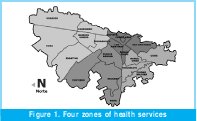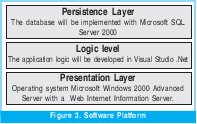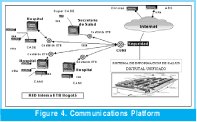DOI:
https://doi.org/10.14483/23448393.2665Published:
2007-11-30Issue:
Vol. 13 No. 2 (2008): July - DecemberSection:
Science, research, academia and developmentManagement System For Public Hospitals In Bogotá City
Keywords:
Administration of Health, Integration services, Telemedicine, services of health, Connectivity, commercial software applications (es).Downloads
References
http://ttt.upv.es/~jbasago/enlaces_por_especialidades/telemedicina/proyectos.html
http://www.upm.es/informacion/revista/htdocs/n39/REVISTA39-La-3.html
http://www.piqueras.org/projecte/index_e.htm
http://www.hermes.ed.ac.uk/default.htm
http://paidos.rediris.es/genysi/viijorp/vii_ae.htm
http://www.ehas.org/portal_es/5Proyectos/pilotocolombia
Universidad Nacional de Colombia Proyecto Telemedicina, Centro de Telemedicina, 2000.
Universidad Distrital de Colombia, "Proyecto Telemedicina Bogotá" , 2004
Universidad Distrital Francisco José de Caldas " Proyecto Sistema de Gestión de Salud para el Distrito Fase II ", 2006
Organismo Andino de Salud, Convenio Hipólito Unanue, Aplicaciones de Telecomunicaciones en Salud en la Subregión Andina,Organización Panaméricana de la Salud 2003, páginas 119-132.
Andrés Martínez, Universidad Politécnica de Madrid, España, Grupo de Bioingeniería y Telemedicina, Bases Metodológicas para Evaluar la Viabilidad y el Impacto de Proyectos de Telemedicina, Organización Panamericana de la Salud, 2001, páginas 79-102.
Cyntia Baur, PhD, Mary Jo Deering, PhD, Proposed Frameworks to Improve the Quality of Health Web Sites: Review, Septiembre 26 de 2007, http:// www.medscape.com/viewarticle/418842_2
Código de conducta HON (salud por la red) http:// www.hon.ch/HONcode/Spanish/
Principios para aplicaciones de salud por internet, Sociedad Médica Americana(AMA) http://www.ama-assn.org/about/ guidelines.htm,http://www.ama-assn.org/ama/pub/ category/1810.html
Código de ética para Salud por Internet, http:// www.hiethics.org/Principles/index.asp
Coalición para Salud por Internet, http:// www.ihealthcoalition.org/ethics/spanish-code.html
How to Cite
APA
ACM
ACS
ABNT
Chicago
Harvard
IEEE
MLA
Turabian
Vancouver
Download Citation
Ciencia, Investigación, Academia y Desarrollo
Ingeniería, 2008-00-00 vol:13 nro:2 pág:18-22
Management system for public hospitals in Bogotá city
Lilia Edith Aparicio Pico
PhD. Telecomunicaciones, Magister en Teleinformática, Directora del grupo de investigación en telemedicina de la Universidad Distrital GITEM.
Iván Alonso Rodríguez Arteaga
Ingeniero Industrial, Especialista en Ingeniería de Producción, miembro grupo de Investigación en Telemedicina GITEM, Universidad Distrital, Ingeniero de procesos y calidad.
Abstract
This article shows a solution for centralized general health information system at the public company "Secretaría Distrital de Salud (SDS)", the SDS administers the general social security system of the District. Also, the system integrates hospitals and their centers of attention through a services network.
The solution includes telecommunications platform and information system to show how to process information about the primary problems in telemedicine networks. The platform of communications foreseen for the development is offered by the Company of Telecommunications of Bogotá (ETB) and the application was developed in commercial platform Microsoft, it uses Visual Studio.net because the .NET Framework is an environment multi-language for the construction, distribution and execution of Services Webs and applications. The. NET Framework is a new platform designed to simplify the development of applications in the distributed environment of Internet.
Keywords: Administration of Health, Integration services, Telemedicine, services of health, Connectivity, commercial software applications.
1. INTRODUCCIÓN
Among the international projects that took like reference for this work is: TELEMEDICINE developed in Edinburgh by three participants: Edinburgh University, Heriot-Watt University and Ferranti, which were involved for the development of a software and hardware for pregnant patients' monitoring. This project was the base of FEST [1,2], TRILOGY [3] and HERMES [4].
CHIN [5] Co-operative Health Information Network, integrates 8 representative regions in Europe, so much metropolitan as rural, with covering to a population of millions of citizens. The CHINS provides a group of telematic ser vices and of integrated health and comprehensible that support real distributed scenarios of work among primary and secondary institutions of health, social and administrative institutions, offering on-line sources of information for the educational sectors or of training.
In Colombia, several projects have been developed that solve characteristic problems of telemedicine, the project Network of Access for the Teleeducation and the Telemedicine developed by the University of the Cauca, it is integrated to the project EHAS [6]. The project has as objective the implementation to the wireless network to integrate services in the occidental zone of Colombia.
The project Network Pilot of Telemedicine - Apoporis - Leticia - Bogotá offers telediagnostic services for dermatology using a satellital network. [7], Another applications can offer many solutions for services as
The Distrital University in Bogotá, carried out a research about the integration of services among the public hospitals of the city [8], the objective of the investigation was to establish the conditions and the existent resources for the telemedicine development in the city. The main result of the research showed a big problem because there are not a sufficient integration between hospitals. This is the work in order to develop telemedicine in Bogotá.
At the present time the medical care offers for levels being managed through exchange of services for the patients among different hospitals where there is opportunity of the service, however not all the hospitals are integrated and this integration is not in net of services. The levels are explained next.
First level: it refers to the population's first contact with the services of health that only have limited resources, it has promotional, educational character basically, of specific protection and of sick persons' that require a simplified medicine, attention as well as the shipment of patient to the second or the third level.
Inside the Hospitals attributed to the SDS, the first level corresponds to the zonal grouping of about 150 units distributed by the city. It includes the Centers of Attention it Prescribes Immediate (CAMI), also, they offer hospital services as the attention of childbirths of low complexity and the observation for 24 or 48 hours. In total they are 19 hospitals of first level that are distributed in the city.
The second level: it is the one that not assists the problems solved in the first level, it not has bigger diagnostic and therapeutic resources for sufferings very complex and that they can require hospitalization. They have the basic specialties clinic of pediatrics, gineco-obstetrics, general surgery and internal medicine.
Attributed to the SDS, there are 8 institutions in this level, they correspond to hospital centers that have an or more than the basic clinical specialties and in some cases with other specialties. Its distribution in the city is irregular although in the northeastern area of the city there is not any public hospital of this complexity.
The third level: this level includes the hospitals and the institutes that have sophisticated resources for the attention of complex cases, they have specialties and they also carry out important teaching works and researching. In this level there are entities attributed to the district that they present big variations among them as for development and size, they are distributed in four areas: north, south, center guides and occident, like it is shown in the figure 1.

In order to establishing the requirements of the system for the integration of services among the hospitals, we made a diagnosis of the operation of the integral system of services among them. We consider the use of all the resources, processes, procedures, instruments and technician-administrative norms, in the Social Companies of the State (SCS) or hospitals and centers of attention of health in Bogotá and the Center Regulator of Urgencies (CRU) located in the facilities of the SDS. A similar model is shown in [16]
As a result main of the research and the development is shown the system that is presented in this paper, where the software and communications platforms are specified. The work was developed with base in international references of other systems of Health as [10], [11], [12]
The main norms that were applied are taken from codes of ethics and norms like [13], [14], [15].
2. MATERIALS AND METHODS
The administration system of patient and services among public hospitals includes the shipment of patient to other hospitals, in this procedure the system should be carried out the coordination among the operative units of the three medical care levels, with the purpose of offering opportune attention and of quality, and to integrate the benefit of the services of health in the population's benefit. This system has as objective to contribute to the agreement patient's integral attention with the necessities and resources of the entity with the purpose of channeling the cases that require it at the different medical care levels.
The system should be a tool that guarantees the integration of the four zones of the attention in health with emphasis in the population linked to the system, offering him an opportune, pertinent and enough answer, among the all hospitals.[9].
The technology infrastructure, computer science and communications TIC that it is shown in the Figure 2, were the base for the system.

Applications: The superior layer involves the services that them will lend on the infrastructure TIC: A portal of Wide Band through which you offers access to the administration system of patient on-line by means of a connection, the application of the system and their associate databases.
The layer of computer technology is composed by computation centers whose main elements are prosecution capacity, operating system, storage, back and security.
Communications: Layer of communications makes reference to an Architecture of the Network of Wide Band, basically the network consists of two parts, each one of them with its corresponding constituent elements of the physical platform of communications which is described next and the second contemplate the programs outline developed in commercial environment
3. DISCUSION
This diagnosis was based in clever of checkup of activities related with the shipment of patient, carried out to Attention to the User, Coordinator of Services of Health at the hospitals and to the Operators and Medical Regulators of Elective and Urgent Attentions of the CRU. Also, surveys were made to users and officials of the SDS. The principals problems that we identified are:
Connectivity: The entities of health distrital don't have a Wide Area Network (WAN) that allows them to share information. The medical community of the public sector is not integrated to the technologies of information, for this reason a mechanism that allows to regulate the information of all the entities and to facilities the administration of the same one in real time doesn't exist.
Processes: In the reference processes or send of patients fixed fringes are assigned and predetermined for the attention of each hospital center generating that they refuse remissions to patient in critical state, for not having opportune information on the level of occupation of the resources, since the transfer of data among the different centers of attention is nonexistent.
A high dependence exists among the different levels of the system of health for its hierarchical organization that makes indispensable the implementation of a network of health. It is not known the level of occupation of the hospitals, briefcase of services and readiness of the appointments, what generates multiple remissions to the patients.
The technological resources are shared among few hospitals, for this reason there are hospitals that are saturated of service and others that waste their resources.
Systems of Information: In the District there is not a system of total information for the exchange of patient between hospitals and the information it is managed in a manual, decentralized way and without an effective control of the processes and resources. The remissions ignoring in most of the cases the readiness of the hospital resources.
Administration System: There is not a Colombian Model of Administration of Health that allows the different actors of the sector and operators of telecommunications to implant telemedicine services.
To solve those problems we develop the information system. It includes: General Social Security Data Base, administration module of patients and the checker module of services for the patients. The administration module of patients: regulates, administers and improves the effectiveness and opportunity of the information with respect to the attention of the users who receives subsidies on the part of the Financial Fund Distrital of Health (FFDS) that require to be referred to other entities, in such a way that is promoted a better opportunity and quality of services by the benefit of the patients. The data base and the checker module are seconds components of general system.
The figure 3 shows the software architecture of the application and the figure 4 shows the telecommunications platform.

The solution includes platfor m of telecommunications and information system to show how to process information about the primary problems in telemedicine networks. The platform of communications foreseen for the development is offered by the Company of Telecommunications of Bogotá (ETB) and the application was developed in commercial platform Microsoft, it uses Visual Studio.net because the .NET Framework is an environment multi-language for the construction, distribution and execution of Services Webs and applications. The. NET Framework is a new platform designed to simplify the development of applications in the distributed environment of Internet

4. RESULTS
- The system was put in service and on approval in 7 hospitals of the areas southwest and center guides. With the following results:
- The appointments to the patients are assigned from the points of attention origin and storage of information is made on the shipment.
- Users' reception in the destination and the reshipment toward point of attention origin.
- Cancellation and reassignment of appointments for users that request it appropriately and report for sanction to those that don't make it.
- Registration of users' information sent by urgencies and hospitalized referred users.
- Registration and upgrade of novelties in services and hospital beds (critical services).
- Briefcase of services or consolidation and consultation of services according to the place and hour of attention.
- As a result of the work has more than enough platform of communications, the system allows:To register and to know in real time the briefcase of services of the public and private hospitals that the SDS defines.
- To administer calendars for medical consultation and procedures of diagnostic and therapeutic support in real time, this process permits:
- To establish the readiness of calendar of these services in the entirety of attributed hospitals and not attributed that the SDS defines, validating, initially the readiness in the hospital of the own subnet and later on in the other networks of services request.
- To select in automatic form, the best opportunity.
- To register the reasons of rejection presented by the user of the destination institution selected in first instance.
- To know the readiness of critical services for services, point of attention and net of services.
- To upgrade and to register changes in the briefcases of services for point of attention
- To generate a steering wheel of instructions with the information on the hour and place of the appointment (including address and telephone of the point of attention destination).
5. DISCUSSION
To build an application web is not easy, many factors exist to have in consideration, the technology helps, but it is a design responsibility and many of the problems in development and quality of the applications can be attacked with appropriate methodologies of development, therefore the quality is fundamental to achieve the success of an application. In another instance some of the main problems of the Information Systems in the organizations today in day they are related with aspects like: the lack of committed users, lacks of an administration in the projects, lack of resources, a clear and detailed methodology is not continued, inflexible methodologies, holes in the practice, there is not an architecture of the system etc. Due to this it is necessary a reliable platform that solves a series of such problems as the handling of standard (Browsers, HTTP, XML, Web Services), low joining, not very predictable latency, scalability, security, dependability, productivity, flexibility, use easiness [], because all users of the health system need the software tools of easy use.
6. CONCLUSIONS
The system supports the resources of information in the points of attention with shared components and the demand of users this distributed correctly.
The network of services among hospitals offers total connection to the system of health of the capital, also it offers spaces in order to prove and to implant telemedicine services, it allows to develop and to establish an unique health of system for the users.
The system is a primary solution in order to develop a telemedicine system at Bogotá, because after the solution of primary problems, we can develop projects about transmission of data signal and images and other information to put it in the clinical histories and around other procedures in medicine.
References
[1] http://ttt.upv.es/~jbasago/enlaces_por_especialidades/ telemedicina/proyectos.html
[2] http://www.upm.es/informacion/revista/htdocs/n39/ REVISTA39-La-3.html
[3] http://www.piqueras.org/projecte/index_e.htm
[4] http://www.hermes.ed.ac.uk/default.htm
[5] http://paidos.rediris.es/genysi/viijorp/vii_ae.htm
[6] http://www.ehas.org/portal_es/5Proyectos/pilotocolombia
[7] Universidad Nacional de Colombia Proyecto Telemedicina, Centro de Telemedicina, 2000.
[8] Universidad Distrital de Colombia, "Proyecto Telemedicina Bogotá" , 2004
[9] Universidad Distrital Francisco José de Caldas " Proyecto Sistema de Gestión de Salud para el Distrito Fase II ", 2006
[10] Organismo Andino de Salud, Convenio Hipólito Unanue, Aplicaciones de Telecomunicaciones en Salud en la Subregión Andina,Organización Panaméricana de la Salud 2003, páginas 119-132.
[11] Andrés Martínez, Universidad Politécnica de Madrid, España, Grupo de Bioingeniería y Telemedicina, Bases Metodológicas para Evaluar la Viabilidad y el Impacto de Proyectos de Telemedicina, Organización Panamericana de la Salud, 2001, páginas 79-102.
[12] Cyntia Baur, PhD, Mary Jo Deering, PhD, Proposed Frameworks to Improve the Quality of Health Web Sites: Review, Septiembre 26 de 2007, http:// www.medscape.com/viewarticle/418842_2
[13] Código de conducta HON (salud por la red) http:// www.hon.ch/HONcode/Spanish/
[14] Principios para aplicaciones de salud por internet, Sociedad Médica Americana(AMA) http://www.ama-assn.org/about/ guidelines.htm, http://www.ama-assn.org/ama/pub/ category/1810.html
[15] Código de ética para Salud por Internet, http:// www.hiethics.org/Principles/index.asp
[16] Coalición para Salud por Internet, http:// www.ihealthcoalition.org/ethics/spanish-code.html
Lilia Edith Aparicio Pico
Dr. Ciencias Técnicas, Profesor Titular Universidad Distrital, Directora del grupo de investigación en telemedicina (GITEM) de la Universidad Distrital Francisco José de Caldas. medicina@udistrital.edu.co
Ivan Alonso Rodriguez Arteaga
Ingeniero Industrial, especialista en Producción, Miembro Grupo GITEM. medicina@udistrial.edu.co
Creation date:
License
From the edition of the V23N3 of year 2018 forward, the Creative Commons License "Attribution-Non-Commercial - No Derivative Works " is changed to the following:
Attribution - Non-Commercial - Share the same: this license allows others to distribute, remix, retouch, and create from your work in a non-commercial way, as long as they give you credit and license their new creations under the same conditions.





2.jpg)










